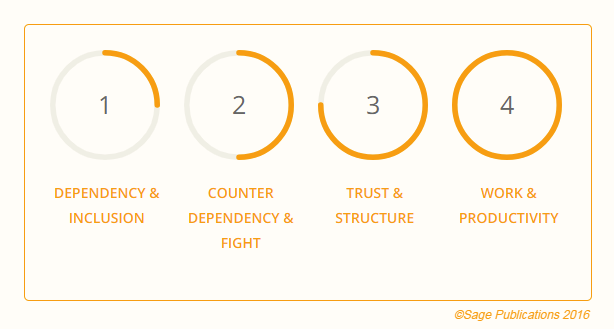Why doesn’t my team get more done? Why do they question my direction? Why won’t my team just get to work? If any of this sounds familiar, the problem probably isn’t the team.
In the first post in this series, we briefly touched on the phases that all teams go through on their way to being great. Teams don’t always travel a linear path through the phases, though, because each team, like each human on the team, is unique. A team may spend more or less time in the various stages. And, they may also revert to a previous stage for a while before moving forward. Changes to the team often set them back until the trust level is restored.
Having some knowledge about team development in general, and the phases in particular gives the team leader tools to best manage the team regardless of their stage. The stages referenced here are from Susan Wheelan’s research into team dynamics.
- Dependency and Inclusion – The team is just beginning their work together. They don’t have a deep relationship with one another yet, so trust has not been established, there is little structure and everyone is dependent on the leader. Team members might be quiet and polite and not speak up much. They won’t generally disagree with anyone, yet.
- Counter dependency and Fight – Team members are feeling more secure and are expressing themselves, disagreeing with one another, and even challenging the leader. It is part of the process, and friction is inevitable. Keep communication open. Remember, this is a stage, like the terrible twos for a toddler, and with time and space for the friction to play itself out, it will pass.
- Trust and Structure – The team has worked through their disagreements and is more comfortable with one another. The friction is largely gone and the conflicts that do occur are dealt with quickly and easily. There is a high level of trust and commitment to the team. There is also less dependence on the leader since structure and roles have developed that allow team members to get on with what needs to be done. More is accomplished at this stage than in the previous two stages.
- Work and Productivity – Nearly all of the team’s energy goes into work and productivity. There is a high degree of trust and commitment, and the leader can act as more of a coach than a director. The team is happier, more creative, and more flexible. Communication is direct and open in this stage.
Sometimes there is a fifth stage, a formal ending of the team and project. This can be valuable to each team member and to the organization. Having time for closure, the team can evaluate what they were able to accomplish and how, and take some time to celebrate the conclusion of the project. Leaders can assimilate what they learned about the dynamics of the team and be better prepared for the next team and project.
Your team is made up of professionals who want to do the best job they can and work gets done in every stage. A team developing towards maturity needs the time to fully realize its potential, but tasks will be completed and deadlines will be met (or missed) while that is happening. Knowing where the team is in their development is valuable in tailoring the way the team is led, thus optimizing their ability to deliver a quality product.
In the next post, we will outline what information the Group Development Questionnaire (GDQ) will give you about your team and how that can help you and your team become more effective and productive.
Let The Propel help you lead your team in the best way possible for the team, the company, and you. Reach out and ask us about our GDQ Team Development process.

Leave A Comment